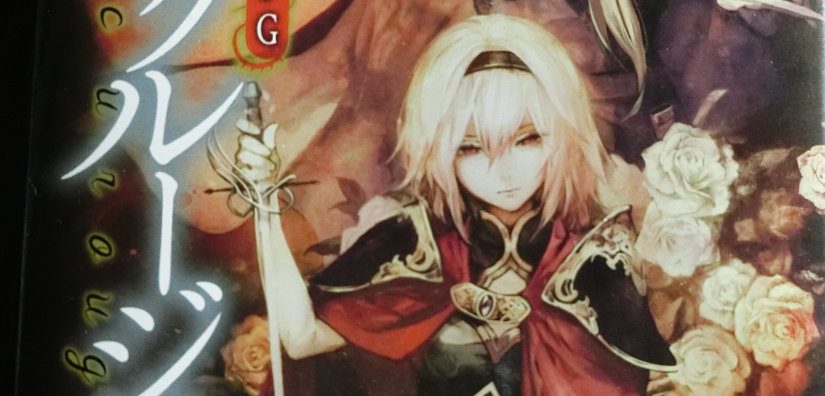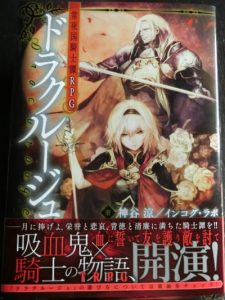
Today we’ll take a look at Dracurouge, a TRPG set in an Everdark country. With the evil sun vanquished, vampire knights are now the protectors of the people.
First of all, the artwork and the ambience it creates is absolutely amazing. The style it affects through language is very immersive, but it also makes it a much harder read than most other TRPGs for me. It goes out of its way to use obscure kanji and words. The majority of the book is black and white, but the first few pages have full color illustrations.
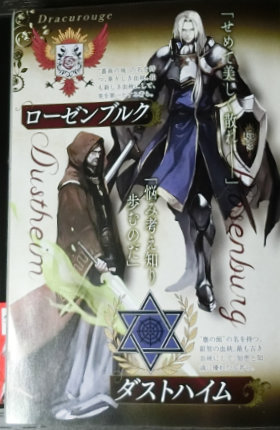
The author is Ryo Kamiya, author of Maid and Golden Sky Stories, both of which have English translations available. The book itself is B6 in size, roughly 13cm by 18cm. Out of its 285 pages, the first 107 pages are a replay of the game.
Replay
Dracurouge skips the formality of rules and after some prose begins with a replay. A replay is a transcript of a game session and a popular format in Japan. Some replays are simply the transcript, but this one has footnotes below the text with further explanations.
Introduction
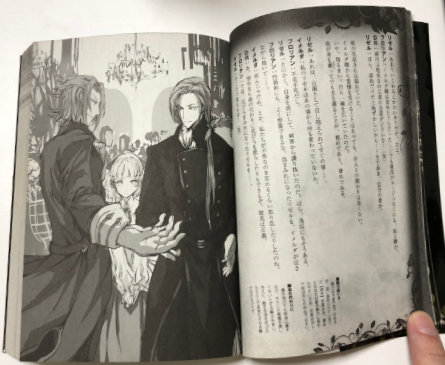
The DR (Game Master) explains the game and the players create characters. During this the DR also gives an overview of the world and its basic concepts.
Dracul finally destroyed the evil sun and now the world is in perpetual darkness. The players are (vampire) knights that protect the populace from monsters, as well as their own who have fallen. Only those who have turned feral suck blood. For those who have not fallen, a kiss on the hand, or if intimate, the neck, is enough to slake their thirst. Each knight deals with two absolutes: Thirst and Warmth.
Next the players receive a handout with plot hooks and suggested traits for their characters. Each player chooses a character and then fleshes them out by rolling on the appropriate tables. The resulting characters were:
- Imelda of House Drac, is a 200 year old vampire in the body of a young girl.
- Lisl of Hellsgarde, an imperial guard and Imelda’s servant.
- Florian of House Rosenburg, a knight-errant.
Bonds between characters are very important. Each player chooses a word from a list to describe their bond with each other player character. Lisl, for example, chose “Trust” for Florian and “Master” for Imelda. Florian on the other hand chose “Respect” for Lisl and “Love” for Imelda. Additionally, each character has an “Indelible Bond” with one of the NPCs defined by the scenario.
The three NPCs that have these bonds are:
- Count Diethelm, host of the formal ball this scenario takes place at. A long time friend of Imelda.
- Lady Warheit Gerlinde Drac “the black dragon”, current head of House Drac. Lisl owes a debt to her that she hopes for a chance to repay it.
- Paula a serving girl working for Count Diethelm and friends with Florian, who rescued her.
Play is divided into acts, each with a different category that determines which abilities can be used. The replay follows that format and has headings for each act, including the intermissions between them.
Act 1 – Normal
The first Act is a “normal” act that takes place at a grand ball held by Count Diethelm. Only abilities in the “normal” category can be used in this type of act. Normal abilities tend to be social in nature, such as “Brilliant Praise” (華やかなる礼讃), and can be used to make social opponents into “wallflowers (literally 壁の花). Becoming a wallflower means the character withdraws from the scene and no longer affects game play.
The characters socialize and dance with various NPCs, causing one to become a wallflower and withdraw. Then, as a toast is being made, Imelda notices that the serving girl Paula is nervous. Upon prying, she discovers that their host Count Diethelm has put his own blood in the wine. Knights are immune to poison, but the townsfolk in attendance are not. Still, the group wonders why he would try to poison them.
Act 2 – Combat
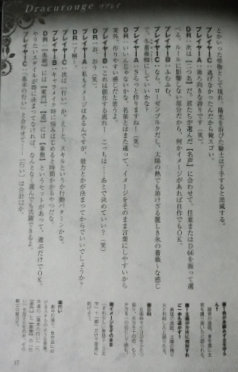
The second Act begins after an interlude where the players manage their resources. This is a combat act, so only combat abilities can be used. The confrontation with their host turns violent and they move to protect Paula. Being made into a wallflower during a combat scene means death for characters other than the PCs.
The host is gravely wounded, but then a bat-like beast of the night with blood-painted skin and some minor beasts attack the town. It comes to light that Count Diethelm has fallen into depravity, and his blood would have affected the knights if they had drunk it.
Act 3 – Finale
In this Act, the action spreads to the town itself. Despite the increase in scope, the name of the ranges remain the same. Being the finale, any abilities, regardless of type, can be used. Imelda protects Lady Wahrheit, who in turn has her guards protect the townspeople. Meanwhile Lisl and Florian take the fight to the beasts. They finally prevail and receive accolades.
Wrapping up
Here they receive experience and can adjust their paths. Imelda failed her roll on the depravity chart table and her path changed to Night Beast (夜獣). She’s not yet lost, but unless she takes drastic actions risks succumbing to her Thirst. Florian decided that his outlook had changed and so changed his path to Feudal Lord.
World and Rules
After the replay, we get some world information before diving into the character creation and rules sections.
World Info
Dracul is the original progenitor that destroyed the evil sun. His six children became the six ducal houses. One of those houses fell, but six bloodlines remain:
- Noble Drac
- Glorious Rosenburg
- Stern Hellsgarde
- Faithful Nosferas
- Wise Dustheim
- Elegant Avaloma
With their greatest weakness the sun destroyed, knights are virtually immortal. They heal from wounds, don’t age, are immune to poison, and a variety of other not so pleasant ways that humans expire. “They don’t know hunger, only the Thirst” (p.109). And when this thirst goes unanswered, they fall into depravity.
飢えるを知らず、ただ渇くのみ。
“They don’t know hunger, only the Thirst.”
The knights now fight fragments of the shattered sun, faeries, monsters, and their own fallen comrades, protecting the lands of the Everdark country. Becoming a knight is called a conferment of decorations (叙勲) and varies from house to house, but is a secret. After this rite is performed, the sire must rest.
History
The evil sun oppressed the people and drove them to endless wars with each other. The so-called vampires at the time had no choice but to feast upon their blood. Humans worshipped the sun out of fear, and it brought misery.
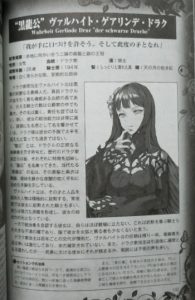
Dracul was born and lived 500 years hiding in the darkness. It was during this time he sired six daughters, who became the heads of the six ducal houses. After 500 years, Dracul’s power was at its height and he was able to challenge the oppressive sun, assaulting it as it rose in the east. Continuing to fight with all his might as the sun scorched him, Dracul eventually won, but was unable to heal himself from his grievous wounds. Some of his ashes encompassed the sun, turning it crimson and caused it to swell in size, the rest fell upon the earth below, becoming a red fog, and thusly after six days the world was baptized by Dracul.
The day was now fully under the care of the moon, which nurtured all, from man to plant, bird to beast, equally. Wars stopped and the world became a better place. There were still evils to be fought, though. A knight must face their own brethren, fallen ones, the army of Hades, and even fae.
The history section details a few more events and provides a timeline summary starting 500 years before the Country of Eternal Night and ending at the current year of the Country 1999. Following that is a map and brief descriptions of the regions.
Next is thirteen pages of NPCs, one per page. These include bios, a drawing, and how they can be used in a game session.
Introduction
It is only now we begin the game section on page 144, roughly half way through the 285 page book. We get a brief introduction to what TRPGs are and what the goal of the game is. This is followed by a summary of game terms and rules, after which we jump into character creation.
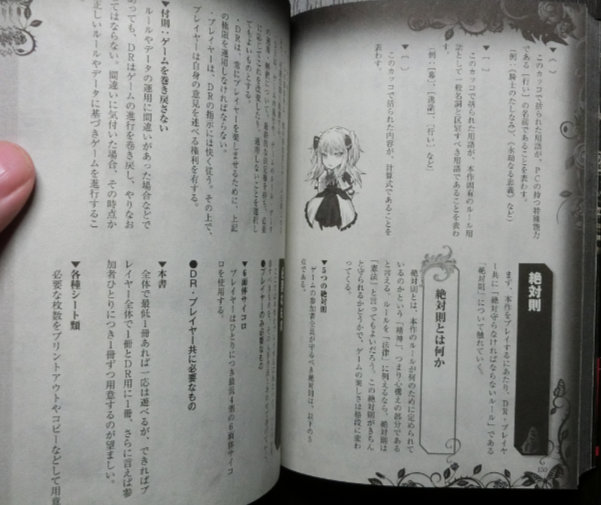
A few terms that stick out as unique to Dracurouge are:
- actualization – the ability for a knight to change reality around them
- anecdote – a special ability that is always active for the knight
- bonds – divided into noir and rouge, these are the relations between characters
- rouge – positive emotions, divided into six types
- noir – negative emotions, divided into six types
- warmth – received with rouge
- thirst – received with noir. Gives power physical power, but too much leads to signs of the beast and a potential fall into depravity
- acclamation points – knights receive this for beautiful acts and it can be spent to increase the number of dice rolled.
Character Creation
The character creation section is divided into two parts: simple and normal creation. Simple creation involves selecting a sample character and making a few customizations, while the standard method is a normal from scratch build.
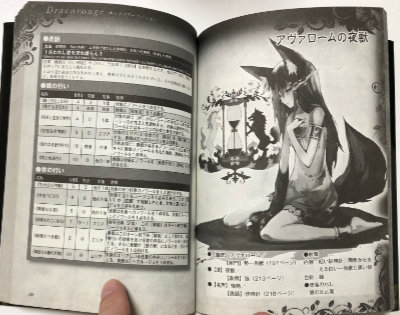
Character details can be chosen or rolled on various charts if you can’t think of something or need inspiration. There are charts for everything, from when and how decorations were conferred to names. As part of this, knights must choose a path they’re on.
All knights share a base set of abilities, but choose three more from a blood line and three from a path. Abilities have a name, effect, flavor text, target number, range, and type of target.
Rules
The rules section begins on page 222 and goes until page 247. While the abilities section was quite detailed, the rules section is fairly minimal. It provides the framework upon which abilities are used. The consistency this affords the game is quite refreshing, allowing both normal and combat acts to be similarly played.
Resources
Players primarily manage four character resources: Warmth, Thirst, Noir, and Rouge. Noir feeds Thirst and Rouge feeds Warmth. Warmth can be used to remove Thirst, while Thirst automatically is added to the highest rolled die. For example, a Thirst of 2 adds a 2 bonus, so if two dice resulted in a 6 and a 2, Thirst automatically turns the 6 into an 8, but the 2 would remain the same.
The downside of Thirst is that if it exceeds a threshold, the player must roll on the fall table (陥落表) to see what the effects of their Thirst is. The worst outcome is complete depravity and the character has fallen. Other effects are growing marks of the beast, such as bat wings or a fox tail and ears.
Bonds
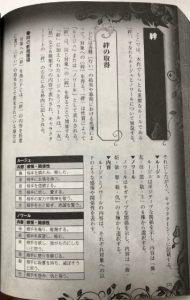
One of the core elements of Dracurouge is Bonds between characters. Each Bond, is defined in terms of positive (rouge) or negative (noir), with the type chosen from a table. For example, the Bond with another player character could be Pity if positive or Contempt if negative.
Bonds with other players or special scenario characters are “Indelible Bonds”. These do not vanish when maxed out. Instead, they reset back to 0 and are built up again.
Interestingly, there is also a bond with oneself (己). It follows the general rules as other bonds, but has some extra implications in certain circumstances.
Abilities
The system is D6-based, with two main rolling mechanics: nD6 and D66. nD6 is the normal roll n six sided dice. D66 is rolling 2D6 and using one as the tens and the other as the ones place, just like two 10 sided dice can be used to roll a percentage.
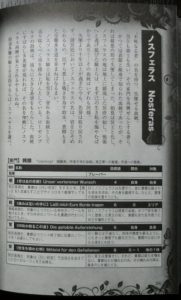
At the beginning of a player’s turn, they roll four dice. These can be used to meet target numbers of various abilities. The ability “How sweet the thorns are” for example, activates on a 6 or higher. Two or more dice that add up to 6 or a single 6 could be used to activate it. Once dice are used for an ability, they are removed from the pool. As long as their target numbers are met, any number of abilities can be used
To give you a sense of what types of abilities are in the game, the following are sample normal and combat abilities. Each power is named in both Japanese and German, so I’ve included both for context.
normal power from the Rosenburg house (p.193)
How sweet the thorns are - 茨の棘は甘く Oh wie süßlich die Dornen sind Target number: 6, Range 0, One other target Action: The knight exchanges one point of rouge with the target. Additionally, if activated with only one die, the target gains an additional point of rouge.
combat power from Avaloma house (p.196)
As in a fairy tale - 御伽の幻想遊戯 Wie in einem Märchen Target number: 8, Range 0~1, One other target Action: Give noir to the target equal to the current round plus one.
Game Flow
The main portion of the game takes place in Acts, each consisting of two rounds. Once the main portion has ended, the final act begins and is played until one side withdraws or conditions are met.
Initiative has the PCs acting before NPCs, but PC order is determined by the path they follow. The book recommends having the players sit in the order of their path at the beginning of the session. A nice touch is that the more bestial a path is, the earlier they act in a round, while the more contemplative paths act later. Once each character has acted, the round is over.
As mentioned above, combat isn’t a special phase in Dracurouge. Instead, the type of Act determines which types of powers can be used (normal or combat) for the entirety of the Act. The final Act is an exception and any power can be used. All powers follow similar mechanics regardless of type.
There are three location categories: Throne (deep), Royal Court (middle), Gardens (near), with paths between each one. The range value on a power determines how many of the location categories it affects.
NPCs are given a “Presence” (存在点) rating that acts as a type of hit points. Once this value reaches 0, they become a wallflower. In non-combat acts, this means they simply withdraw from the scene. In combat acts, the character dies.
Dracul Section
The book ends with a section dedicated to the DR (Game Master) that includes NPC and monster stats, plus a brief scenario.
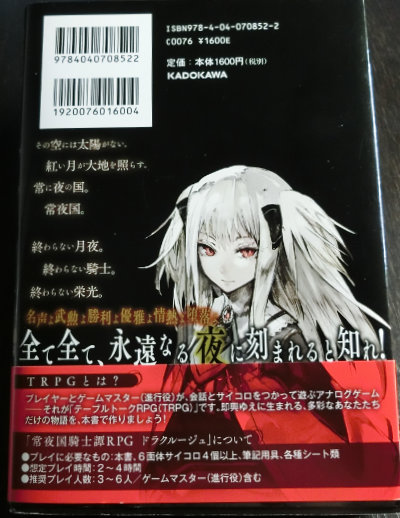
Language
As mentioned above, the language used in the flavor text drips with atmosphere. It accomplishes this through several means, namely its liberal use of kanji and esoteric word usage. The book makes ample use of vampire terms, heraldry, flowery language, and stage terms. For extra fun, German is interspersed in the power names and images, but it’s never necessary for actual play.
Replay Sample
「そこな遍歴の武勇、誠に誉れあるものであった。されどー」p. 65
“A truly honorable knight-errant was there. Be that as it may-”
Flavor Sample
曰く強き憎悪は万物に疵を刻む。貴卿が刻んだ傷は癒えず、時経るほどに敵の心を蝕むであろう。p. 210
Hatred carves flaws in all that is. As the lord’s wounds refuse to heal, so too shall the passage of time gnaw at the enemy’s heart. The word 貴卿 is used frequently in Dracurouge and is apparently read きけい.
Rules Sample
運命具現化:対象はサイコロを振った直後にこの「運命具現化」を解除してもよい。そのときすべての出目を1なら6、2なら5、3なら4とする。
Actualization of Fate: the Actualization of Fate may be cancelled immediately after the target rolls dice. When cancelled, the results of all dice change as follows: 1 becomes 6, 2 becomes 5, and 3 becomes 4.
GM Screen
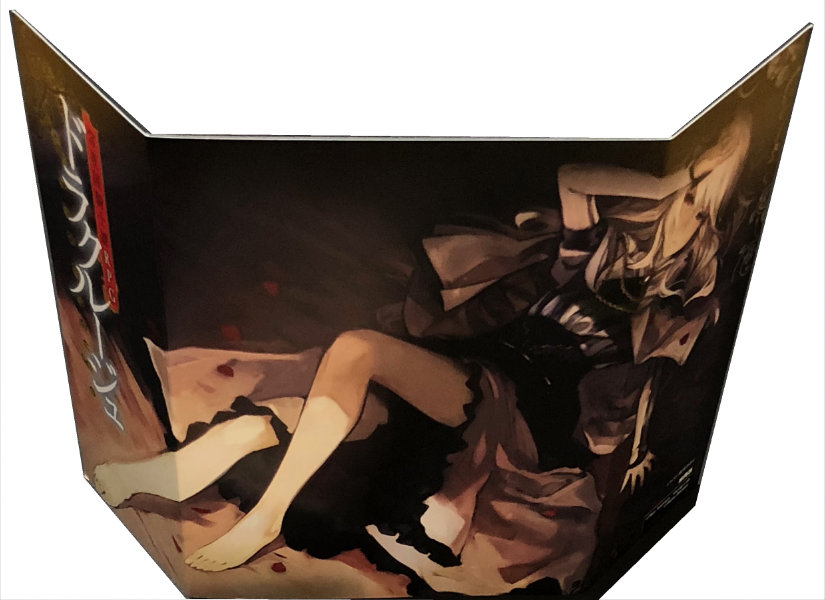
I picked up my copy of Dracurouge at Role and Roll Station Akihabara soon after launch and received a free three pane A4-sized GM screen. Used to the larger three to four panel screens of western RPGs, the small size initially took me by surprise, but is quite convenient.
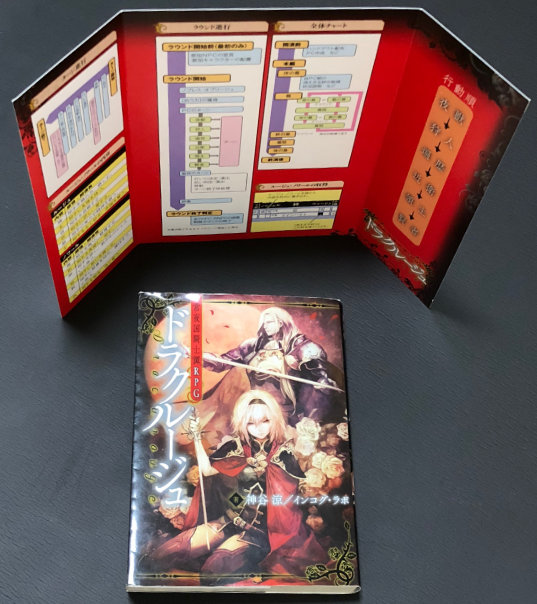
The back of the screen contains charts diagraming the composition of turns, rounds, and the overall game. Below those are lists of Bonds (絆) and how gaining noir or rouge from a Bond works. On the far right is a list of action order, from “Night Beast” to “Scholar”. The more in control of themselves they are, the slower the character is.
Final Thoughts
Drawn to its artwork and further intrigued by its theme, I picked this book up soon after it was released in 2016. Despite my initial enthusiasm, the difficulty of the language deterred my initial attempts to read it. I’m glad I revisited it and finally persevered, though, as it was a very interesting read. There’s a certain rhythm that develops from its consistent, if esoteric, language usage that draws the reader in. I heartily recommend it for those interested, but be prepared for a difficult read.
| Dracurouge (ドラクルージュ) | |
|---|---|
| Publisher | Kadokawa |
| Author | Ryo Kamiya / Incog Lab |
| Support Page | |
| Support Blog | |
| Online Retailer | Amazon Japan |
| Released | 2016-3-25 |

